John of the Cross
1. Sharing Jesus' Prayer
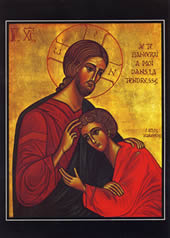
This icon is of John, the author of the fourth gospel, leaning against the breast of Jesus at the last supper. In his gospel John's aim is to share with us what he learned there.
Note the halo around Jesus head. It contains the Greek words ho on, which are the words used in the Septuagint to translate God's words in Exodus chapter 3, when, at the burning bus, Moses asks God who he is, and God replies 'I am who I am (ego eimi ho on)': What John discovered from being close to Jesus' heart is Jesus' divinity: his intimate communion with God whom he called 'Abba'. John was drawn into Jesus' communion with his Father - into Jesus' prayer.
John wrote his gospel to invite his readers to share this intimacy: to go where John went in order to share in Jesus' prayer.
For the rest of this retreat, let us imagine that this is a picture of John of the Cross, contemplating Jesus, the one he calls 'the Beloved', and inviting us, through his writings, to join him there.
It was Paul who said: 'I live no longer I, it is Christ who lives in me'. He could just as truly have said: 'I pray no longer I, it is Christ who prays in me. Opening our heart to allow Jesus to pray there is what we mean by contemplation.
In Presentation 2 I will begin to explore John's teaching with you, drawing on 'The Impact of God: soundings from St John of the Cross' by Iain Matthew (Hodder & Stoughton, 1995). In this presentation we will keep our focus on Jesus, and on Jesus' prayer.
Jesus revealed God as Love. Love does not control, nor does it impose itself. For God to enter the human condition, he must be welcomed. It was Jesus' grace-filled response that opened the way for God to enter fully into the human condition.

Jesus always welcomed God's offer of love,and grew in communion from the beginning till he final breath. This icon depicts Jesus' Baptism, which was clearly an especially sigificant experience for Jesus. He was overwhelmed with love, and knew that his mission was to overwhelm others with this same love.
The Prologue to John's Gospel.
John begins his gospel by taking his readers back to Genesis chapter one: the creation. Echoing the wordfs of God: 'Let it be', he states: 'In the beginning was the Word and the Word was towards God, and the Word was God. The Word was towards God in the beginning.'
The whole of creation participates is the Being of God. There is a gravity drawing everything and everyone towards communion with the Creator. The following is a photo of that part of creation that is special to us: the blue globe we call home.

John continues: 'All things came into being through God's Word, and with God's Word not one thing came to be.' Included here is homo sapiens. 'Adam' and God's gift to him of 'Eve' are represented on the ceiling of the Sistine Chapel by Michaelangelo:
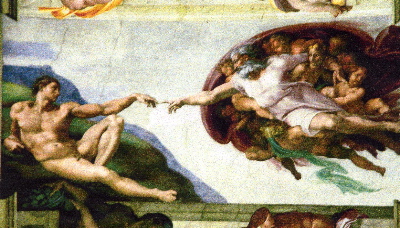
John continues: 'What has come into beling in the Word was life, and life was the light of all people. The light shines in the darkness, and the darkness did not overcome it. The true light, which enlightens everyone (note John's all-inclusive message) was colming into the world. God's Word was in the world, and the world came into being through God's Word; yet the world did not know God's Word.' John will qualify this statement shortly, but when he looked at his world, what struck him was the failure of people to recognise God's gift of Self, God's love.
John then focuses on Israel: his own culture: 'God's Word came to what was God's own, and God's own people did not accept God's Word.' The people of Israel (as the prophets kept saying) were no better. However - and here John speaks of those of every culture who have listened to God's Word (whether they realised it or not) and welcomed God's love: 'But to all who received the Word, God's Word gave power to become children of God. These were born, not of blood (it is not hereditary), or the will of the flesh (it's not something we can achieve by our own determined efforts), or male will, but of God.' God alsone is the source of grace, including our response. The following is an icon of a Jew kissing the scroll:

However, it was only, finally, in Jesus, that God’s Word was embraced fully, and entered into the communion with creation that God had always willed (John 1:14). This is what those who knew Jesus experienced when they experienced Jesus’ love, and it is this that they wanted to share with everyone.
John concludes his Prologue:
The Word became flesh and lived among us,
and we have seen his glory,
the glory as of a father’s only son,
full of the gift of truth.
From his fullness we have all received,
grace upon grace.
The law indeed was given through Moses;
the gift truth came through Jesus Christ.
No one has ever seen God.
It is God the only Son, who is in the bosom of the Father,
who has made him known.
Thanks to Jesus, and through communion with him, we are able to ‘live and live to the full’(John 10:10).
= to be ‘saved’: to experience the fulfilment of our deepest longings in love-communion with God and so with creation.
In Paul’s words” ‘in Christ God was reconciling the world to himself’(2Corinthians 5:19).
In John’s words: ‘God so loved the world that he gave his only Son, so that everyone who believes in him may not perish but may have eternal life’(John 3:16).
Hence the conviction of Jesus’ followers that they must carry on the mission of Jesus by sharing the Good News with ‘all nations’(Matthew 28:19).
Because he perfectly responded to grace, Jesus is a gift for everyone. In Jesus, at last, we can see God reconciling the world to Himself
Living in communion with Jesus we are able to live in such a way that God can be ‘everything to everyone’ (1Corinthians 15:28)
At the heart of Jesus’ disciples attraction to him was their experience of his special relationship to God. Again and again the Gospels speak of Jesus’ prayer.
Having described a busy day in Jesus’ ministry, Mark writes that Jesus left the house to find a secluded place where he could be alone in prayer (see Mark 1:35).
Luke tells us that ‘many crowds would gather to hear Jesus and to be cured of their diseases. but he would withdraw to deserted places and pray’(Luke 5:16).
Before selecting his twelve disciples, ‘Jesus went out to the mountain to pray, and spent the whole night in prayer to God’(Luke 6:12).
It was after he had been praying alone that he asked his disciples who they thought he was (see Luke 9:18).
Matthew, Mark and Luke all describe the scene where ‘Jesus took with him Peter and John and James, and went up on the mountain to pray’(Luke 9:28). They go on to describe the transfiguration (Matthew 17:1-8; Mark 9:2-8; Luke 9:28-36).
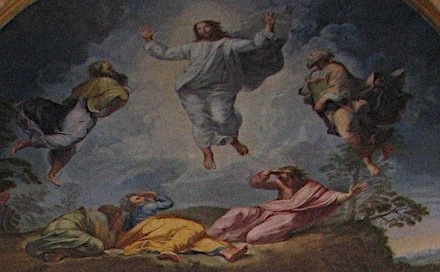
This prayer reveals the special intimacy Jesus experienced with God, whom he addresses as ‘Father’.
It was this special relationship that fascinated Jesus’ disciples, and, more than anything else attracted them to him. It was this, too, that scandalised the religious leaders (John 5:18). Jesus knew that his being and his mission were from the Father (John 5:26; 5:30).
Luke records that on one occasion the disciples, seeing Jesus at prayer asked him: ‘Lord, teach us to pray’(Luke 11:1). Jesus spoke of God as their Father, too (see Matthew 6:14-15; 6:26; 6:32; 7:11; Luke 11:13; 12:30), and they wanted to share the kind of intimacy with God that was so apparent in Jesus. This intimate communion with God is what John calls ‘eternal life’(see John 3:16; 4:14).
In the following icon Jesus is inviting us: 'Come to me all you who labour and are over-burdened and I will give you rest. Learn from me, for I am gentle and humble in heart, and you will find rest for your souls:
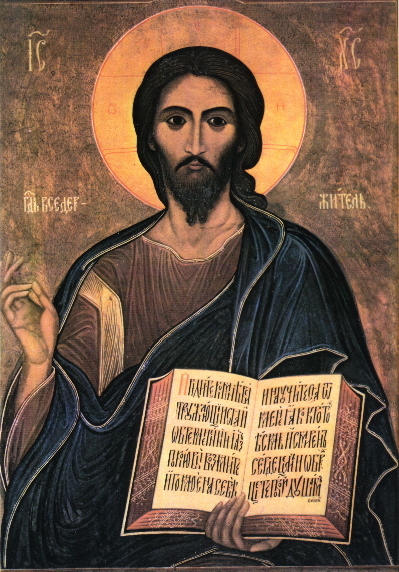
Matthew, Mark and Luke describe Jesus’ anguished prayer
in Gethsemani (see Matthew 26:36-46; Mark 14:32-42; Luke 22:39-46; compare John 12:27).
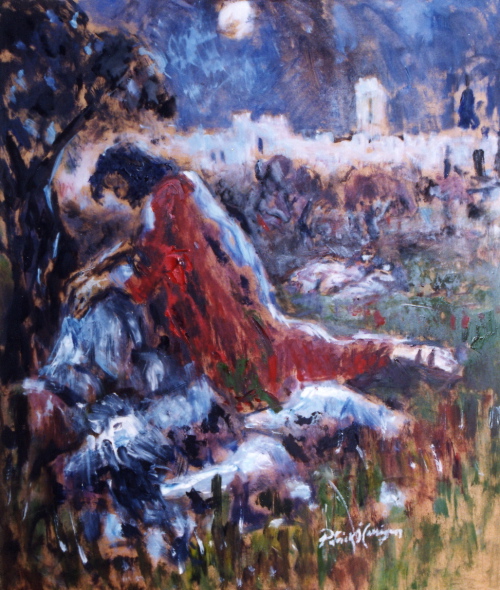
Jesus’ humanity, but also his faith in God are, perhaps, nowhere shown more poignantly that in his cry from the cross: ‘My God, my God, why have you forsaken me?’(Matthew 27:46; Mark 15:34).
It is his faith in God that Luke highlights when he records Jesus’ prayer from the cross: ‘Father, into your hands I commend my spirit’(23:46).

No one brings out the intimacy of Jesus with God better
than the Beloved Disciple,
who leaned against Jesus’ breast at the Last Supper,
and stood by the cross with Jesus’ mother.
Everything Jesus said or did came from this special communion. John writes: ‘The Father loves the Son and has placed everything in his hands’(John 3:35).
His special communion did not protect him from the suffering that is part of the human experience, but it sustained him, and the fruit of this communion was a loving that his disciples had never previously experienced: a love for them, indeed for the world, that flowed from his loving communion with God